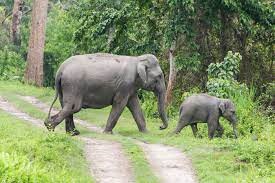Description

Disclaimer: Copyright infringement not intended.
Context
- For peaceful co-existence with wild elephants, the Indian army has generated a unique ecosystem in Amchang wildlife sanctuary.
- It has an aim to to mitigate the human-elephant conflict in the Sanctuary.
Details
- There are frequent visits of wild elephants, who are living in the Amchang Wildlife Sanctuary, to the military station increasing the danger of human – animal confrontation.
- In a bid to provide them food and water, several ponds are created and also fruit trees and grasses are planted for wild elephants.
- Army personnel also cleared paths for the free movement of elephants.
- Awareness programs are being undertaken to educate and alert the citizens within Military station.
- This ecosystem is created in collaboration with the local community, scientific community and forest officials.
|
Ecosystem
An ecosystem is a community of organisms and their physical environment interacting together.
It also refers to a geographic area where plants, animals, and other organisms, as well as weather and landscapes, work together to form a bubble of life.
Hence it is considered a system of various communities, their interactions (exchange of energy and recycling of the nutrients) and, the physical environment together.
|
Amchang Wildlife Sanctuary
- This is a small Sanctuary, famous for rare and endangered animals and birds, located in the eastern fringe of Guwahati city, Assam.
- It was declared as a wildlife sanctuary on 19th June, 2004 by the government of Assam.
- It comes under the East-Kamrup Forest division of Kamrup district and is spreading in an area of 78.64 sq. kms.
- It comprises areas of reserved forests of the Amchang, South Amchang and Khanapara.

Disclaimer: Copyright infringement not intended
Fauna
Mammals
- Rare animals like Chinese pangolin and Slow loris.
- Flying fox, Assamese macaque, Rhesus macaque, Capped langur, Hoolock gibbon, Jungle cat, Leopard cat, Leopard, Asian Elephant, Wild pig, Sambar, Barking deer, Gaur, Porcupine etc
Birds and Butterflies
- Lesser Adjutant, Greater Adjutant, White-backed Vulture, Slender-billed Vulture, Khaleej Pheasant Green Imperial Pigeon, Lesser Pied Hornbill etc.
- It is a home to more than 750 species of butterflies and 360 species of moths.
- Amchang is also considered an Important Bird & Biodiversity Area.
Reptiles
- Python, Monitor Lizard, Indian Cobra etc.
Flora
- Forest type - Eastern Himalayan moist deciduous forest.
- Famous Tree - Yellow butterfly.
- Other species - Bombax ceiba, Dalbergia sissoo, Sterculia villosa, Trewia nudiflora, Zizyphus jujuba, Phragmites karka, Arundo donax, Imperata cylindrica, Enhydra fluctuans etc.
|
Important Bird and Biodiversity Area (IBA)
IBA is a programme of Birdlife International to identify, monitor and protect a global network of IBAs. Hence these serve as conservation areas, including wetlands, mudflats, grasslands and scrublands etc., for protection of birds at the global, regional or sub-regional level.
Objectives – Conservation of the world's birds and associated biodiversity.
In India 554 IBAs have been identified by The Bombay Natural History Society (BNHS) and Birdlife International.
|
Threats
- Continuous extension of city limits.
- Due to excessive exploitation pressure on the natural resources of this wildlife sanctuary.
- Other anthropogenic activities including construction.
- Rapid industrialisation.
- Increased pace of deforestation.
Wild life Sanctuaries in India
- Wildlife Sanctuary, refers to a protected area of adequate ecological, faunal, floral, geomorphological, natural or zoological significance.
- It is reserved exclusively for wildlife use, especially those in danger of extinction and the rare ones, for protecting, propagating or developing them or its environment.
- Wildlife sanctuaries of India, are classified as IUCN Category IV protected areas.
- However some restricted human activities are allowed inside the Sanctuary area governed by the rule mentioned in Chapter IV, WPA 1972.
- There are 567 existing wildlife sanctuaries in India covering an area of 125564.86 square km.
|
Protected Areas of India
Protected areas are those in which human occupation or at least the exploitation of resources is limited. There are several kinds of protected areas, which vary by level of protection and the legal framework of a country
In India, there exists below type of protected areas –
- Marine Protected Area
- National Parks
- Wildlife Sanctuaries
- Conservation Reserves
- Community Reserves
|
|
PRACTICE QUESTION
Consider the below statements about Wildlife-sanctuaries in India:
1. Wildlife-sanctuaries are also designated as Important Bird And Biodiversity Areas
2. No human activity is allowed as these are protected and reserved for wild life use
Which of the above statements is/are true?
a) 1 only
b) 2 only
c) Both
d) Neither 1 nor 2
Correct Answer: (d)
|

https://tourism.gov.in/sites/default/files/2023-04/9%20Compendium%20Book_2021_Low%20%281%29%20%282%29.pdf
http://www.assaminfo.com/tourist-places/44/amchang-wildlife-sanctuary.htm
https://thewire.in/environment/700-families-left-homeless-assam-governments-eviction-drive-amchang-wildlife-sanctuary
http://wiienvis.nic.in/database/iba_8463.aspx
https://www.indiatoday.in/education-today/gk-current-affairs/story/difference-between-wildlife-sanctuaries-and-national-parks-1724972-2020-09-24
http://wiienvis.nic.in/Database/wls_8230.aspx
http://wiienvis.nic.in/database/protected_area_854.aspx
https://www.google.com/url?sa=i&url=https%3A%2F%2Fjournals.dbuniversity.ac.in%2Fojs%2Findex.php%2FAJET%2Farticle%2Fdownload%2F341%2Fpdf_60&psig=AOvVaw27PEZDOdEAkknIwlmLm4aL&ust=1686112830226000&source=images&cd=vfe&ved=0CBIQjhxqFwoTCOCP-_Pprf8CFQAAAAAdAAAAABAS












